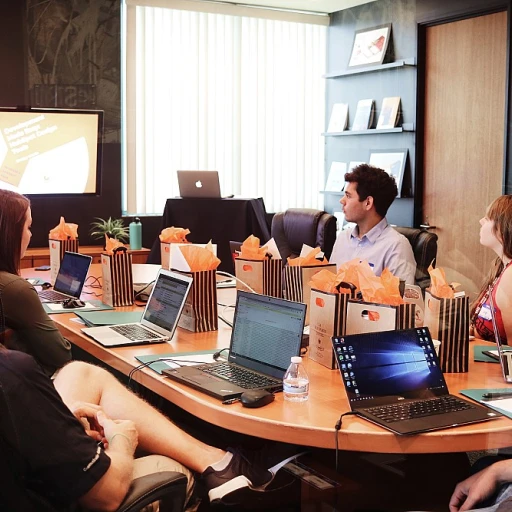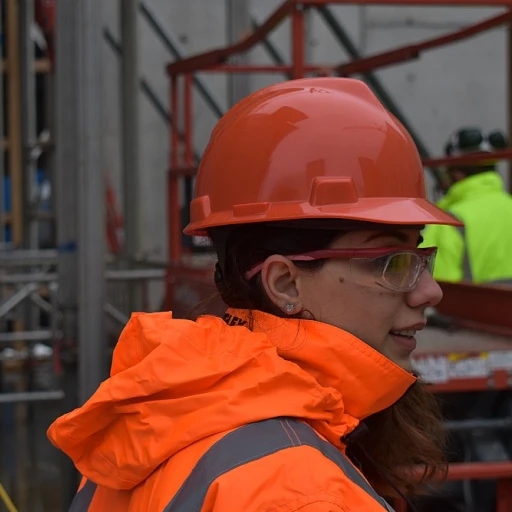
Understanding the Need for Reskilling in Senior Management
Recognizing the Necessity for Skill Upgrades in Management
In today’s rapidly evolving business landscape, the need for reskilling among senior management has become increasingly apparent. Senior managers, including those at the Disney Company, face unique challenges as they navigate the complexities of a global market that demands continuous learning and adaptability. With the pace of technological advancements and shifting market dynamics, companies like Amazon and Disney are seeing a growing necessity for their leaders to embrace lifelong learning and development. The role of a director or vice president now demands more than just traditional managerial skills. These positions require a sophisticated understanding of new technologies and strategies for talent development to keep their teams at the forefront of innovation. The need isn’t limited to executive or senior management roles; it extends to areas such as software development and financial services, where skills need a constant update. Many years ago, the skills required for these roles were vastly different. The advent of new software, changes in global business strategies, and the digitization of services have necessitated a shift in how companies like Walt Disney view the concept of manager learning. Today, there is a keen focus on practical, hands-on experience, rather than solely on theoretical knowledge. Companies across the United States, such as Disney, have recognized the critical need to evolve their training programs. Reskilling initiatives are not only about maintaining competitive advantage; they are about ensuring that senior directors and other leaders are equipped to meet the challenges of their roles effectively. Senior executives must be prepared to leverage new insights and innovative tools to drive company growth forward. By understanding the need for proficient training development, organizations can position their directors of learning and senior learning development managers to be more effective. Senior managers need access to structured learning opportunities that address both current skills gaps and future challenges. Exploring the role of a comprehensive learning center can offer valuable insights into developing such robust educational frameworks. Emphasizing the strategic importance of upgrading skills across the full-time roles not only improves productivity but also increases job satisfaction and employee retention. For the Disney Company, these initiatives align with broader company objectives, ensuring that managerial training is not just another checkbox but a crucial component of their growth strategy.Disney's Approach to Training Strategy
Walt Disney's Comprehensive Strategy for Managerial Growth
At the heart of Disney's approach to training and development lies a robust framework that aims to keep senior managers ahead in a fast-evolving industry. A primary focus is on nurturing the diverse skills of its senior management team to align with the company's global goals. Here’s how Disney effectively executes its training strategy:- Personalized Learning: Recognizing the unique needs of each senior manager, Disney emphasizes tailored learning experiences. This personalization ensures that each manager can thrive in their role and contribute to the overall success of the company.
- Cross-Departmental Collaboration: Senior managers are encouraged to engage with other departments to exchange knowledge and skills. This cross-pollination of ideas reinforces a collaborative culture, vital for creative companies like Disney.
- Onsite and Global Exposure: Managers often partake in both onsite and international site visits to understand how Disney operates globally. These experiences are invaluable in shaping a manager’s perspective and enhancing their adaptability.
- Use of Advanced Learning Technologies: Disney incorporates the latest learning technologies into their training programs. This includes digital platforms and interactive software development tools that facilitate remote learning and skills assessment.
- Continuous Feedback Mechanisms: Feedback is integral to Disney’s managerial training. Senior managers are encouraged to seek and provide constructive feedback, fostering a continuous cycle of improvement and learning development.
Key Components of an Effective Training Program
Core Elements of a Robust Training Strategy
Crafting an efficient training strategy for senior managers at a company like Disney entails focusing on several crucial components. Each aspect must be tailored to meet the evolving demands faced by leaders in dynamic fields. A comprehensive strategy ensures that senior management possesses the necessary skills to drive the company forward and meet its strategic goals.
The first component centers around the identification of learning and development needs specific to senior executive roles within the Disney company. Executives, including those holding titles like vice president, director global, or senior director, need specialized content that aligns with both global trends and the unique cultural environment at Walt Disney. This involves engagement with development managers who can tailor programs to these needs.
Secondly, a focus on experiential learning ensures that senior managers do not only gain theoretic knowledge but also practical application and hands-on experience. This might involve simulations, site visits, or mentorship programs where tangible outcomes from learning interventions can be observed.
Furthermore, incorporating technology and innovative tools can enhance the learning experience. For instance, the use of software development platforms to simulate scenarios for senior learning can provide real-time feedback and complex decision-making environments. This not only aids in learning but also helps in streamlining processes that might have been cumbersome ago.
Finally, the contribution of a talent development department is indispensable. Their role includes continuously updating content to ensure its relevance in the context of industry's changes and jobs landscape. Employing an adaptable program manager is key to incorporating feedback and adjusting training pathways promptly.
While integrating these elements might seem challenging, it is this multi-faceted approach that allows Disney to maintain its status as a leader in united states and beyond. Tailored, dynamic, and strategically aligned training forms the backbone of ensuring that senior management roles at the Disney Company are consistently effective and future-ready. For insights on enhancing workforce agility, check out this approach to competency management. This perspective supports continuous learning and adaptability at all managerial levels, further promoting the overall development of the director learning and manager learning through a comprehensive training framework.
Innovative Delivery Methods for Managerial Training
Revolutionizing Training Delivery with Modern Techniques
In the ever-evolving realm of professional development, delivering managerial training through innovative methods has become a priority for organizations. The necessity for a dynamic approach is underscored by the shift in learning environments and the increasing demand for skill enhancement among senior executives. With companies like Walt Disney placing emphasis on the importance of reskilling, modern training strategies often highlight a blend of cutting-edge technology and engaging content delivery. Here's how the Disney company integrates these strategies:- Virtual Learning Platforms: To accommodate the global spread of employees, virtual platforms have become a staple, allowing senior managers to access training resources from any location. These platforms offer flexibility for both full-time and part-time employees.
- Gamification: Incorporating gamification elements into training programs can increase engagement and retention among senior directors and managers. This technique transforms mundane learning modules into competitive, interactive experiences.
- Customized Training Pathways: Recognizing the diverse backgrounds and previous experiences of senior staff, tailored training modules have proven effective in addressing the specific needs of each employee.
- Simulation-Based Learning: Simulation exercises provide an immersive learning experience, tackling real-world scenarios that managers might face in their roles. This approach equips them with practical skills, enhancing their decision-making abilities.
- Blended Learning Models: Complementing traditional methods with digital solutions ensures a comprehensive learning experience. For instance, combining face-to-face workshops with online modules offers a multi-faceted approach to skills development.
Overcoming Challenges in Training Delivery
Addressing Barriers in Training Implementation
Navigating the landscape of training delivery presents a unique set of challenges, especially when crafting programs for senior managers at a company as expansive as Disney. One major barrier is time allocation. Senior executives, who often lead the charge in various strategic roles, including that of a director or vice president, frequently juggle multiple responsibilities. Allocating sufficient time for learning and development becomes an uphill task. To overcome this, companies can adopt flexible training schedules and integrate learning into the manager's existing workflow. This could involve the use of concise, targeted sessions that allow senior managers to actively participate without compromising their full-time roles. Additionally, advanced software development platforms for learning management can facilitate seamless planning and execution of training programs by enabling self-paced modules that fit into the demanding schedules of senior executives. Another significant challenge is ensuring that the training methodologies resonate with the experiences and expectations of senior personnel. For instance, traditional training methods may need to be supplemented with innovative delivery models that engage this experienced cohort. By leveraging digital and interactive media, programs can capture the attention of senior talent. Incorporating case studies relevant to their jobs or using real-life examples from successful companies like Amazon or financial services firms can make the learning experience more relatable and impactful. Furthermore, aligning training content with the strategic goals of the company is crucial. Senior managers are typically driven by the company's global objectives, thus training content must be calibrated to enhance the skills that directly support these objectives. A bespoke training approach that considers the individual needs of senior managers, tailored to the specific requirements of each department, be it marketing, services, or site management, is more likely to yield significant results. Engaging external providers can also be beneficial, bringing in fresh perspectives and expertise to guide the development of training content. For instance, partnering with firms that have experience in delivering targeted learning solutions for executives can ensure the program remains cutting-edge and directly applicable to the company's needs. Ultimately, ensuring consistent communication and follow-up with senior leaders can affirm the value of training and help in the ongoing enhancement of managerial skills. Continuous feedback loops, where senior managers can share their learning development experiences, will foster a culture of perpetual growth and innovation within the Disney company and beyond.Measuring the Impact of Training on Managerial Performance
Evaluating the Efficacy of Managerial Training at Disney
Measuring the impact of training programs on managerial performance is a crucial aspect of creating a successful development strategy. At Disney, the focus is not just on the completion of training modules but on tangible improvements in the skills and performance of senior managers and executives. This involves both quantitative and qualitative assessments.- Performance Metrics: One of the primary methods used is a detailed analysis of performance metrics that assess changes in productivity, team leadership, and decision-making abilities. These metrics provide a clear view of how well the training outcomes align with the company's objectives.
- Feedback and Surveys: Gathering feedback from senior managers, directors, and executives is also vital. This feedback often comes through structured surveys and open-ended discussions, allowing managers to express the real-world applicability of new skills and concepts learned through the training process.
- Business Impact Analysis: The link between managerial training and business results is another significant measure. This involves examining how training influences operational efficiency, innovation, and ultimately, the financial performance of Disney Company. All these point towards achieving a sustainable competitive advantage in the united global market.
- Continuous Monitoring and Adjustment: Ongoing evaluations ensure that the training remains relevant and up to date with emerging trends and technologies. It helps identify any areas where the training might need improvement or where additional resources might be beneficial.












